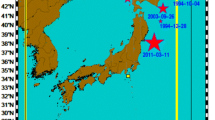Summary
More than 20 coseismic resistivity steps were observed by a resistivity variometer at a station about 60 km south of Tokyo during a six-year period of observation. The logarithmic magnitude of steps normalized to an epicentral distance (δ) of 100 km is linearly correlated to earthquake magnitude (M). The larger the earthquake magnitude is, the longer is the time required for completing a resistivity step.
Earthquakes, that produced a step, as plotted on anM-δ graph are clearly separated by a straight line
from those that did not produce a step, δ being measured in units of km. The straight line is approximately equivalent to a resolution of strain steps of the order of 10−9. As the smallest rate of resistivity change that can be observed by the variometer is 10−5 or so, it is apparent that mechanical strain is amplified by a factor of 104 or thereabouts when it is measured in terms of resistivity change.
Some of the steps are preceded by a premonitory effect. When long-period changes, mostly due to tidal loadings, are eliminated by a numerical filtration technique, precursors are brought out very clearly in a number of cases. The precursor time ranges from 1 to 7 hours and appears to be independent of magnitude.
Similar content being viewed by others
References
Y. Yamazaki,Electrical conductivity of strained rocks (the 1 st paper), Laboratory experiments on sedimentary rocks, Bull Earthquake Res. Inst.44 (1965), 783–802.
Y. Yamazaki,Electrical conductivity of strained rocks (the 2nd paper), Further experiments on sedimentary rocks. Bull. Earthquake Res. Inst.44 (1966), 1553–1570.
Y. Yamazaki,Electrical conductivity of strained rocks (the 3rd paper), A resistivity variometer, Bull. Earthquake Res. Inst.45 (1967), 849–860.
Y. Yamazaki,Electrical conductivity of strained rocks (the 4th paper), Improvement of the resistivity variometer, Bull. Earthquake Res. Inst.46 (1968), 957–964.
Y. Yamazaki,Coseismic resistivity steps, Tectonophysics22 (1974), 159–171.
T. Rikitake andY. Yamazaki,Electrical conductivity of strained rocks (the 5th paper), Residual strains associated with large earthquakes as observed by a resistivity variometer, Bull. Earthquake Res. Inst.47 (1969), 99–105.
T. Rikitake andY. Yamazaki,Strain step as observed by a resistivity variometer, Tectonophysics9 (1969), 197–203.
C. J. Wideman andM. W. Major,Strain steps associated with earthquakes, Bull. Seism. Soc. Amer.57 (1967), 1429–1444.
R. G. Mason,Spatial dependence of time variations of the geomagnetic field in the range 24 hr to 3 min on Christmas Island, Geophys. Dept. Imp., Coll. Sci. Technol., London, Publ.63-3 (1963), 1–20.
C. H. Scholz, L. R. Sykes andY. P. Aggarwal,Earthquake prediction: a physical basis, Science181 (1973), 803–810.
J. H. Whitcomb, J. D. Garmany andD. L. Anderson,Earthquake prediction: variation of seismic velocities before the San Fernando earthquake, Science181 (1973), 632–635.
I. Tsubokawa,On relation between duration of precursory geophysical phenomena and duration of crustal movement before earthquake, J. Geod. Soc. Japan19 (1973), 116–119 (in Japanese).
Author information
Authors and Affiliations
Rights and permissions
About this article
Cite this article
Yamazaki, Y. Precursory and coseismic resistivity changes. PAGEOPH 113, 219–227 (1975). https://doi.org/10.1007/BF01592912
Received:
Issue Date:
DOI: https://doi.org/10.1007/BF01592912



